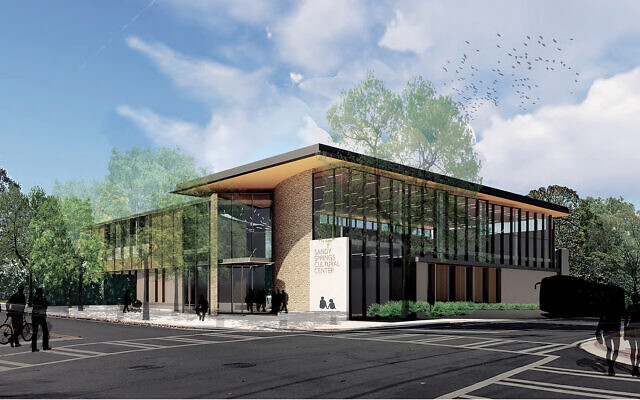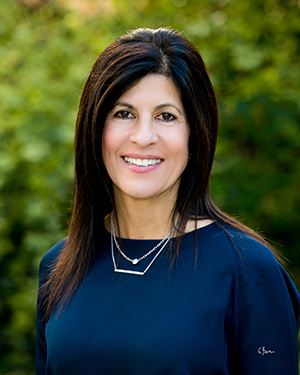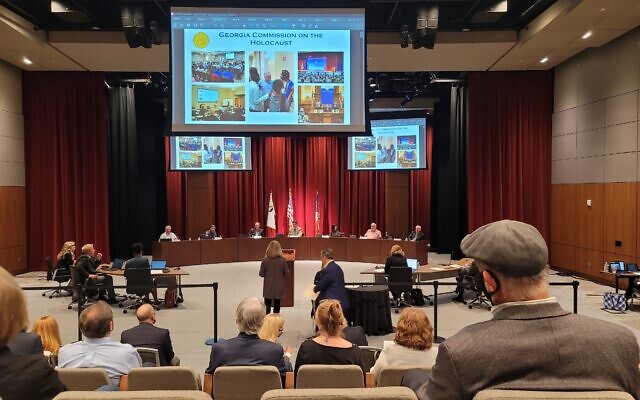Sandy Springs Weighs In on Anne Frank Exhibit
A proposed facility on the City Springs campus for use by the Georgia Commission on the Holocaust has sparked considerable public interest.
Dave Schechter is a veteran journalist whose career includes writing and producing reports from Israel and elsewhere in the Middle East.
The current home of the “Anne Frank in the World: 1929-45” exhibit is above Chef Rob’s Caribbean Cafe in the Parkside Shops on Roswell Road just south of Hammond Drive in Sandy Springs.
Six-tenths of a mile north, where Roswell Road crosses Mount Vernon Highway, is the City Springs campus and the gleaming building that houses the city’s government and performing arts center, fronted by the city green.
The Georgia Commission on the Holocaust, a taxpayer-supported state agency, hopes to relocate the Anne Frank exhibit to City Springs and a new home for that and other Holocaust education exhibits.
A proposal before the city council would have the city expend an estimated $2.9 million to $3.3 million to erect an 8,300-square foot “cultural center” across from the entrance to the performing arts center. The Holocaust commission would lease about 7,000 square feet, more than 80 percent of the space, and make annual payments of $150,000 for 20 years, with an option for an additional 20 years. Possible uses mentioned for the remaining space include a city-operated gallery and offices for Visit Sandy Springs and the Sandy Springs Perimeter Chamber. The city would be responsible for the building’s security and maintenance.

Last September, the six-member city council unanimously approved a non-binding resolution in support of GCH and development at the site. Based on that action, the nonprofit Friends of the Georgia Holocaust Commission, Inc., began raising money to service a lease and fund exhibits. Thus far, $3 million has been raised, toward a goal of $5.5 million. The group’s fundraising letter says that it “is dedicated to the construction of a new, custom designed building and installation of interactive, state-of-the-art exhibits on the campus of Sandy Springs City Center.”
The city council has received a flood of comments from taxpayers and other interested parties, representing a range of opinions about the project’s financing, location and necessity. At the May 4 council meeting, Mayor Rusty Paul said that no decision had been made and no date set for any votes. “We’ve got a lot of information that we’ve got to now digest,” Paul said.
In an email to the AJT, Paul said: “This is a project mandated by the Georgia legislature and it’s going somewhere in Metro Atlanta. I believe Sandy Springs, with its robust Jewish community, is the ideal location for it. My predecessor, Eva Galambos, brought the exhibit to Sandy Springs more than a decade ago and it clearly needs updating. Her dedication to the exhibition is seen in her request that at her death any donations be directed to the ‘Anne Frank in the World’ exhibit.”
Chuck Berk, a member of the boards of both GCH and its fundraising arm, told the city council’s May 4 meeting, “This is really a big deal. We’re not just moving the old exhibit. We’re planning seven world class exhibits. They deserve to be in a prominent location on the City Springs campus.” GCH’s offices also would be in the building.

Fundraising material highlights an “interactive and more engaging” Anne Frank exhibit, with materials from the Anne Frank House in Amsterdam. One feature would be a full-scale replica of the rooms — measuring 46 square meters (approximately 500 square feet) — shared by Anne Frank, her parents, sister, and four other people from July 1942 to August 1944, until they were discovered by the Nazis. Frank died at age 15, on March 31, 1945, in the Bergen-Belsen concentration camp.
Another planned attraction would be the high-tech “Dimensions in Testimony” presentation created by the USC Shoah Foundation, which allows visitors to ask questions to holographic images of Holocaust survivors, who respond with answers from their recorded interviews.
“Witness to the Holocaust: WWII Veteran William Alexander Scott III at Buchenwald” would focus on the experiences of the African-American Army sergeant and photographer from Atlanta, who witnessed the liberation of the Buchenwald camp.
“Georgia’s Connection to the Holocaust – What Did Georgians Know?” would include the voices of survivors and veterans who liberated concentration camps.
“Americans and the Holocaust,” an exhibit from the United States Holocaust Memorial Museum, uses newspapers, magazines and other artifacts to show what Americans knew during that period.
“Democracy in Action” would concentrate on moral issues raised by the Holocaust and ask visitors to “consider the responsibilities and obligations of citizens in a free and democratic country.”
A planned Holocaust Memorial Garden outdoors would include a cutting from the chestnut tree that grew outside the building where Anne Frank hid, and a life-size statue of the girl whose diary is read worldwide.
A bill passed by the General Assembly in 2018 states that the commission “shall design, procure, and place in a prominent location a Georgia Holocaust Memorial to recognize and commemorate the millions of people, including six million Jews, murdered by the Nazis and their collaborators before and during World War.” Berk told the AJT that GCH executive director Sally Levine “prefers the ‘memorial’ be an educational and teaching tool, not just a stagnant item.”
Already on the National Register of Historic Places is the Memorial to the Six Million at Greenwood Cemetery, south of Interstate 20 along Cascade Avenue. That Holocaust memorial was erected in 1965 by Eternal-Life Hemshech, Inc., an organization of survivors and their families in Atlanta.
Before COVID-19 forced its closure, the current Anne Frank exhibit annually received more than 7,000 visitors. The Holocaust commission sees the potential to welcome 25,000 to 30,000 visitors annually at City Springs.

Among council members, Jody Reichel has been outspoken with her concerns. In her April newsletter, Reichel wrote that, while supporting GCH’s mission, “I cannot support the use of taxpayer dollars on a Cultural Arts Center in Sandy Springs as it is currently presented. It has been brought to my attention that the Georgia Commission on the Holocaust can improve upon existing Anne Frank exhibits at The Breman Center and Kennesaw State University by using donated private money and would not require government funding. In my four years in office and my many years being an active member of our community, I have not heard my neighbors and constituents say they want taxpayer dollars to fund a cultural arts center. Rather, I regularly hear comments that they are interested in trails, parks, restaurants, retail shops, athletic space such as pickleball courts, sidewalks, and help with stormwater issues and smart development in the North End.”
Two other potential sites have been considered for the project. The city already has spent $2 million on architectural design work and $1.8 million to purchase the site of a former automobile repair shop at Hildebrand Drive and Blue Stone Road. That is adjacent to the Heritage Sandy Springs museum and park. At an April 6 working session, a staff presentation to the city council showed the City Springs option with the lowest estimated construction cost, and noted access to existing services, including its parking structure.
The Holocaust commission was created in 1986 by Gov. Joe Frank Harris and re-established by Gov. Zell Miller in 1991. The General Assembly made GCH a permanent agency in 1998, placing it under the secretary of state’s office. It later moved to the Department of Community Affairs, and last year to the Board of Regents of the University System of Georgia. GCH was appropriated a total of $344,560 in the fiscal year 2021 amended budget and the same amount for fiscal 2022. Its 15-member board is comprised of five appointees each by the governor, the speaker of the House, and the president of the Senate.
According to its website, GCH annually provides Holocaust education training to more than 250 teachers, sponsors speaker programs that reach more than 20,000 Georgians, sends traveling exhibitions throughout the state, and records testimonies of Holocaust survivors and concentration camp liberators.
Discussion of the project has included how a new GCH center would mesh with the Museum of History and Holocaust Education at Kennesaw State University (18 miles from Sandy Springs) and the William Breman Jewish Heritage Museum in Atlanta (10 miles).
According to a state budget document, putting GCH under the Board of Regents would “leverage operational efficiencies and eliminate duplicative services” with the Kennesaw State museum. In addition to exhibits on the participation of Georgians in World War II, the Kennesaw State collection includes Holocaust educational and research materials, and oral histories. The Anne Frank exhibit had been housed at KSU and then at the old courthouse in Decatur before moving to Sandy Springs in 2010.
Officials at the Kennesaw State museum declined to comment for this article.
Adam Koplan, vice chair of The Breman Museum’s board, told the May 4 city council meeting that, as a nonprofit, “We do not and cannot advocate for any political position or particular use of city or any governmental funds.” Without taking a position on any real estate decision, Koplan said that The Breman “is currently in discussions” with the GCH and the Friends of the Georgia Holocaust Commission on “potential collaboration and support of the Holocaust education efforts the Commission plans to undertake in Sandy Springs, including the potential creation of an exhibition focusing on Georgia Holocaust survivors.”
The Breman Museum’s permanent exhibit, “Absence of Humanity: The Holocaust Years, 1933-1945,” traces the destruction of eastern Europe’s Jewish population. The Breman also is home to The Lillian and A.J. Weinberg Center for Holocaust Education, which provides teachers with educational materials, in-class speakers, and sponsors a Summer Institute on Teaching the Holocaust. The Breman maintains a roster of locally based Holocaust survivors who speak to groups, including school children, through the program “Bearing Witness: Unforgettable Stories from the Holocaust.” According to its annual report, the Breman received 28,100 visitors in fiscal year 2018-19.
In letters to a GCH board member and the mayor, Jarvin Levison, president of The Breman Foundation, a nonprofit that supports the museum, expressed concern that the proposed facility would compete with the Breman for attendance — particularly by school students — and money, helping neither. Levison also wrote that, “Any memorial the state is creating should be located either at the State Capitol or somewhere nearby where numerous people from all over the state and visitors are more likely to see it and know that the state has taken a position. The state of Georgia should not be paying for a memorial to the Holocaust victims and have it located in Sandy Springs or any other similar community.”
Note: Atlanta Jewish Times owner-publisher Michael Morris is a member of the Georgia Commission on the Holocaust board and the “Friends of” GCH fundraising committee. Morris was not involved in the reporting of this story.
- Dave Schechter
- Anne Frank
- Sandy Springs
- city springs
- Georgia Commission on the Holocaust
- holocaust
- Visit Sandy Springs
- Sandy Springs Perimeter Chamber
- Georgia Holocaust Commission
- Mayor Rusty Paul
- Eva Galambos
- Bergen-Belsen
- Chuck Berk
- News
- USC Shoah Foundation
- United States Holocaust Memorial Museum
- Holocaust memorial garden
- Greenwood Cemetery
- Sally Levine
- Jody Reichel
- Eternal Life Hemshech
- Kennesaw State University
- Breman Jewish Heritage Museum
- Adam Koplan
- The Breman Foundation
- Michael Morris
- Local




comments